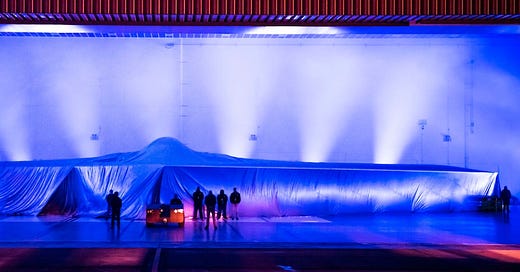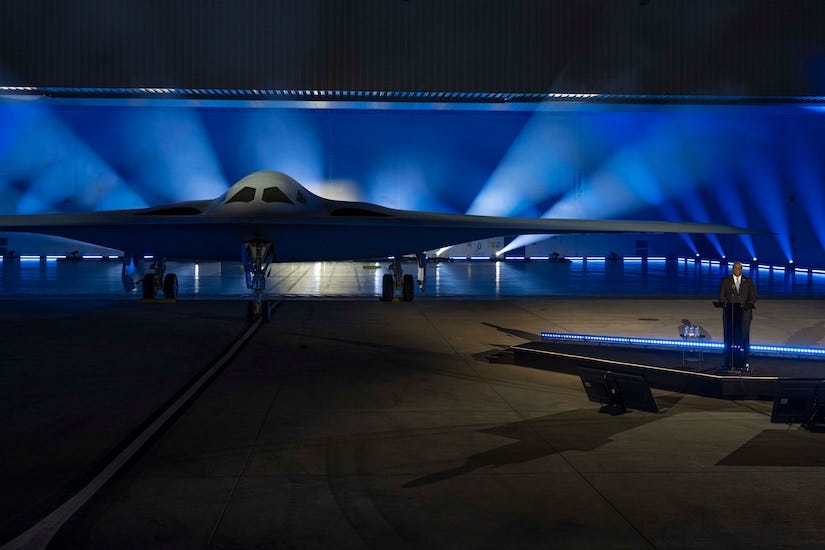Raiding the sky with the B-21
The most advanced and the most ambitious nation building machine.
As technology continues to advance, it has become increasingly important for nation-building. Technology as a source of military innovation is hot stuff within the U.S. defense establishment right now.
Where we see the most application of technology on the nation-state level is when it’s used to enhance national security. The use of advanced surveillance and monitoring technologies can help to detect and prevent potential security threats, such as terrorism or cyber-attacks. Additionally, the development of new technologies for defense and security purposes can help to protect national interests and maintain national sovereignty.
Innovation makes policymakers swoon and weapons developers salivate. As such, innovation and “breakthrough” or “revolutionary” technologies is a match made in heaven. The fit is both easy to see and easy to communicate to stakeholders such as the public, Congress, service branches, and industry.
The debate about revolutionary technology presents one important insight: The rapid development of new technologies for both civil and military use poses both a threat and an opportunity for the U.S. armed forces. It is an opportunity for military organizations to deter enemies and, if necessary, make war better, faster, more effective, and less risky. But it is also a threat in that the development and operational use of advanced technologies are no longer an exclusive prerogative of the United States. Near-peer rivals such as China and Russia are becoming more technologically advanced, while the militarization of commercial technology poses an increasing threat from non-state actors.
So what’s the United States’ answer?
Let’s begin by asking ourselves a question.
What military inventions shifted the world?
It all started with sticks and stones, swords and spears. The invention of the crossbow came to full fruition with the Chinese army sporting 50,000 crossbows in 209 BCE, which allowed for more accurate and powerful ranged weaponry. The development of gunpowder and firearms, also invented in China in the 9th century, revolutionized warfare and led to the creation of new weapons such as cannons and muskets. The creation of the steam engine, in 18th century England, was used to power ships and eventually led to the development of tanks and other armored vehicles. The final major innovation breakthrough has been the development of aircraft and the invention of the airplane, in the 20th century, which allowed for new forms of warfare and the ability to strike targets from the air and cemented the delivery of nuclear weapons- ushering in a new era of global power and deterrence.
With most military technology seeming like its headed to automones robots, machines, and computer chips, the United States is going all in by betting future warfare will be determined from whoever controls the sky.
The French have Airbus, The Turks have their Bayraktar, The Canadians their Bombarider, The Russians with their SU’s & Migs… the list gets extensive.
But what other nations lack in comparative advantage is the intellectual and technical prowess of the American Aerospace Industrial Complex.
Developed during World War II, the American Air Force played a crucial role in securing victory for the Allies. The United States entered the war in 1941 after the attack on Pearl Harbor, and quickly began building up its fleet. American planes and pilots proved to be highly effective in a number of key engagements, including the Battle of Midway, Philliphines, & Coral Sea and the bombing campaigns against Germany and Mainland Japan. Additionally, the United States had a major advantage in terms of industrial capacity, which allowed them to quickly produce a large number of aircraft, over three hundred thousand aircraft from 1940 to 1945. The legacy continues 80 years later as the United States Airforce introduced the Northrop Grumman produced B-21 Raider, paying homage to the team who accomplished, what some said was an impossible mission, to change the course of World War II.
At the hangar of aircraft manufacturer Northrop Grumman, the B-21 was unveiled amidst dramatic music and lighting effects. The new bomber has a silhouette similar to that of the B-2 Spirit bomber.
The B-21 bomber, also known as the Long Range Strike-Bomber (LRS-B), is a game-changer for American military technology. This advanced aircraft will be a crucial tool for maintaining America's military superiority for years to come.
It's a testament to America's enduring advantages in ingenuity and innovation and it's proof of the department's long-term commitment to building advanced capabilities that will fortify America's ability to deter aggression, today and into the future."
Secretary of Defense Lloyd J. Austin III
One of the most exciting aspects of the B-21 bomber is its stealth capabilities. This aircraft is designed to be nearly invisible to radar, allowing it to penetrate enemy airspace without being detected. This will be a major advantage for American forces, as it will allow them to carry out bombing missions without being intercepted by enemy air defenses.
In addition to its stealth capabilities, the B-21 bomber will also be equipped with state-of-the-art technology and weapons systems. This will allow it to strike targets with incredible precision, even in the face of heavily defended enemy positions. It will also be able to carry a wide range of payloads, including both conventional and nuclear weapons.
Another key advantage of the B-21 bomber is its long range. This aircraft will be able to fly long distances without the need for mid-air refueling, allowing it to reach targets that other bombers cannot. This will be a valuable asset in any potential conflict, as it will give American forces the ability to strike targets deep inside enemy territory.
Overall, the B-21 bomber represents a major step forward for American military technology. Its advanced capabilities will be crucial for maintaining America's military superiority and will give armed forces the tools they need to succeed in ever 21st century conflict.
The B-21 Raider’s superiority is vital for the success of American military operations and the defense of the nation. It’s also a 300 Billion Dollar project, bringing jobs and economnic stimilus to diverse locations throughout the United States. It provides tactical advantages on the battlefield and strategic benefits for a nation's security and influence. Development on the B-21 Raider began in 2015 when the Air Force awarded the engineering and manufacturing development contract. The Air Force expects to acquire a minimum of 100 of the aircraft.
Like the Doolittle Raiders during WWII, the B-21 Raider is expected to do the same now and into the future. This isn't just another airplane. It's not just another acquisition. It's the embodiment of America's determination to defend its interests and its allies. It's a testament to strategy of deterrence — with the capabilities to back it up, every time and everywhere. That's what current American military doctronie is all about.






Thanks for the interesting article on this new upcoming model!